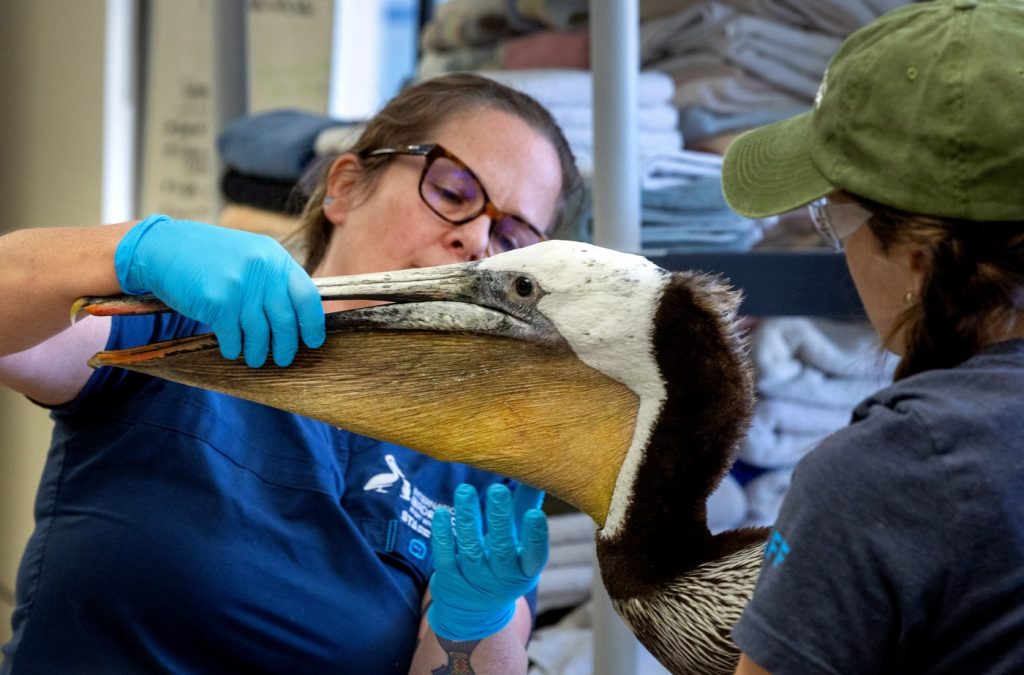There’s a broken link in the food chain of California’s brown pelicans, adding a sad chapter to one of conservation’s most striking success stories.
Emaciated birds are turning up in California’s ponds, reservoirs, backyards and even San Francisco’s Oracle Park during a baseball game — far from their wild ocean home.
Wildlife centers are inundated with the gangly, prehistoric-looking seabirds, nursing them back to health with fluids, fish and medications, but the cost is a staggering $1,500 per bird. Injuries can easily double the cost.
SEE ALSO: One of world’s rarest whales sighted off Point Reyes coast
“They’re feathered skeletons,” said Rebecca Duerr, director of research and veterinary science at International Bird Rescue, which is treating 200 pelicans at its Fairfield center and 70 pelicans in Los Angeles. “Hunched over and folded up.”
For weeks, scientists have been perplexed by this tragic die-off. Other birds are doing fine.
Now they have a theory: There’s food, but the pelicans can’t reach it. It’s too deep, or too far offshore.
While heartbreaking, the deaths are a natural fluctuation that does not doom the species — unless it continues, said seabird biologists Jim Howard of the California Institute of Environmental Studies and David Mazurkiewicz of Channel Islands National Park, who monitor breeding colonies.
Smaller crises have been noted in previous years — 2022, 2018, 2012 and 2010 — but not at the current scale. Many of those birds had the same symptoms: emaciated, dehydrated, critically low body temperatures. Fortunately, populations rebounded.
“If we begin to see more frequency in these events, it could be cause for concern over a long time period,” said Mazurkiewicz.
The brown pelican, whose wingspan measures seven feet, is beloved for its soaring flight and dramatic capture of prey, with a headfirst dive in the water from great heights.
After 40 million years of survival, the species has faced many recent existential threats.
In the late 1800s, pelicans were hunted for food and feathers. During World War I, they were seen as competitors for the sardines needed to feed troops, so were shot by fishermen. In the 1960s, the insecticide DDT caused their eggs to weaken, then crack. Even today, they face ongoing danger from fish hooks.
The Endangered Species Act protected the birds from extinction in 1970. By 2009, the population soared so high that it was no longer officially protected, and now the total population of brown pelicans ranges from 30,000 to 40,000 in California, according to Howard.
So far this year, 707 birds have been brought into care facilities for treatment, according to the California Department of Fish and Wildlife. Of these, about half are still in care or recovered and have been released. The other half died or had to be euthanized. Many more have died in the wild, unnoticed.
Birds that normally weigh 6 to 10 pounds are now 5 to 8 pounds, said Duerr. Without enough fat to stay warm, their body temperatures have plummeted from 104 to 98 degrees, or colder. They’re anemic. They’re dehydrated. And they’re often injured, because hungry pelicans take extra risks, venturing near fishing hooks and lines.
In Santa Cruz, Native Animal Rescue has taken in 215 brown pelicans, compared to 35 last year. SPCA Monterey has rescued 109 pelicans.
SEE ALSO: Elusive surfboard-stealing Otter 841 back in Santa Cruz, up to her old tricks
Even the San Francisco Peninsula, far inland from the birds’ natural range, is getting them. “We had been getting flooded with calls about dead pelicans and pelicans in distress,” said Colleen Crowley of Peninsula Humane Society and SPCA in Burlingame.
The birds are looking for food wherever they can find it. In the past weeks, they’ve been seen in San Rafael’s Las Gallinas Wildlife Ponds, Vasona Lake in Los Gatos and Almaden Lake and Calero Reservoir in San Jose.
A social animal, it is rarely found alone. So it was startling to see a sole pelican land in the outfield during the fifth inning of a Giants-Reds game earlier this month. Baseball fans were charmed — but that’s not normal pelican behavior.
Experts are struggling to identify what’s behind the strange behavior. One initial suspect was domoic acid, a neurotoxin produced by microscopic algae. Another was a disease, like avian flu. But those causes have been ruled out. The birds are simply starving.
Now the focus is on the northern anchovy, the primary food of pelicans. The tiny fish gather in big black clouds that sparkle underwater and can drop deep, or swim far out to sea.
When food is plentiful, pelicans store up sufficient energy to produce eggs, incubate and feed as many as three chicks. But overfishing and warm waters are threatening their breeding populations in the Gulf of Mexico, said experts.
And this winter there was very little food, said seabird ecologist Enriqueta Velarde of Universidad Veracruzana in Jalapa, Mexico. This resulted in near-complete reproductive failure. Then the birds left for California, she said.
“They moved up here early. And some of them were here all winter, which is very unusual for us,” said Bart Selby of the NOAA Monterey Bay National Marine Sanctuary Conservation Working Group, who bands pelicans. Typically, large numbers start arriving at the end of June.
Related Articles
Elusive surfboard-stealing Otter 841 back in Santa Cruz, up to her old tricks
One of world’s rarest whales sighted off Point Reyes coast
Oakland man asks how to discourage squirrels from ravaging his fruit trees, garden
Mountain lion prompts lockdown at Aptos High School
Moose kills Alaska man attempting to take photos of her newborn calves
What’s going on? Earlier in the year, there was a shift in the global climate pattern — specifically, El Niño, said Andrew Thompson, Research Fisheries Biologist at NOAA’s Fisheries Science Center La Jolla. While the water temperature off our coast is now normal, El Niño caused warmer-than-normal ocean surface temperatures in the eastern tropical Pacific Ocean.
SEE ALSO: Point Reyes seashore study favors elk fence removal
This year’s anchovy count is down a bit, after several years of growth, Thompson said. And the fish might be further off shore, so it’s harder for pelicans to find them.
“The majority of the anchovies have moved,” said commercial fisherman Richard Ogg of Bodega Bay. “Earlier this year, I saw very large schools of pinhead anchovies. However, as it turned out, the wind kicked up, the water got cold, and the anchovies disappeared.”
The fish don’t like rough water, so the cold and windy storms of April and early May likely pushed the anchovies deeper, said Thompson.
Pelicans only plunge a few feet deep. And surface waves obscure the birds’ visibility.
“Whatever is affecting the anchovies — within the water column or across the continental shelf — is going to affect the pelicans,” said Deborah Jaques of Pacific Eco Logic in Crescent City, who surveys roosts from Pismo Beach to Crescent City. “If that changes, it can suddenly put the pelicans out of business.”
This occurred at a critical time in the bird’s life cycle.
“Nature can be very cruel in our eyes sometimes,” said Ogg. “But there is a reason for all that occurs, whether we see it or not. We can only try to learn and understand the possibilities.”


